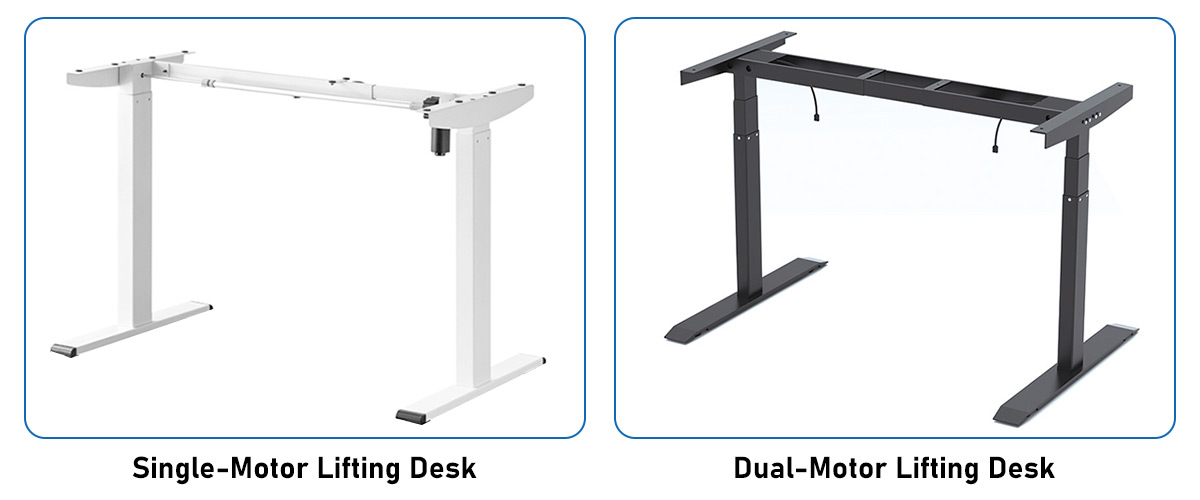The difference between single motor lifting table and double motor lifting table
In modern office and daily life, people's attention to health is increasing day by day, and electric lifting desks have gradually become the new favorite of many households and workplaces. It can effectively improve people's sedentary habits and reduce the pressure on the lumbar and cervical vertebrae. At present, electric lift desks on the market are mainly divided into two types: single motor and dual motor. Taking DIHOOL lifting desk as an example, let's explore the differences between the two.

I. Drive mode
Single motor: The single motor lifting desk has only one motor, usually installed on one of the table legs, and the lifting is completed by linking the two lifting columns through the synchronous pulleys, which is similar to the power distribution mechanism of the "two-wheel drive car". Due to single-point drive, uneven power distribution may occur, affecting the lifting stability.
Dual motor: The two legs of the dual motor lifting desk are each driven by a motor, which independently drives the lifting columns on both sides. The controller coordinates and synchronizes the operation, similar to a "four-wheel drive car" structure, with more balanced power output and smoother and more stable lifting process.
II. Performance differences
Load Capacity
Single motor: Due to limitations in the number of motors and power transmission methods, the load-bearing capacity of a single motor lifting desk is relatively limited. Generally speaking, its load-bearing range is around 70-80 kg, which is more suitable for lifting desks with a desktop size of 0.9-1.6 meters. When the weight of items placed on the desktop exceeds its load-bearing range, it not only significantly slows down the lifting speed, but may also cause instability in the lifting process, and even damage the motor, affecting the service life of the lifting desk.
Dual motor: The dual motor lifting desk has significantly increased its load-bearing capacity due to the power provided by two motors. Under normal circumstances, the load-bearing range of a dual motor lifting desk can reach 120-160 kg, which can easily handle larger desktop sizes of 1.2-2.1 meters. This means that it can carry more heavy objects such as office equipment and documents, and can handle various usage scenarios with ease.
Lifting speed
Single motor: The lifting speed of a single motor lifting desk is relatively slow, generally around 25mm/s. This is because a single motor needs to power two lifting columns at the same time, and there will be certain losses during the power transmission process, and the power of the motor is usually relatively small, making it difficult to achieve rapid lifting. For those who need to adjust the desktop height frequently, the lifting speed of a single-motor lifting desk may affect the user experience to a certain extent.
Dual motor: The two motors of the dual motor lift desk work together to provide more powerful power, so their lifting speed is significantly faster than the single motor lift table. Generally, the lifting speed of a dual-motor lifting desk can reach 30 - 40mm/s. Users can adjust the desktop to the required height in a short time by pressing the button, which greatly improves usage efficiency and meets users' needs for quick and convenient adjustment of the desktop height.
Lifting Stability
Single motor: During the lifting process of a single motor lifting desk, since the two desk legs are driven by a transmission shaft, it is easy to cause uneven force on both sides, which causes the table to tilt or shake when lifting. This situation is even more obvious, especially when the desktop load is unevenly distributed.
Dual motor: The dual motor lifting desk can maintain better stability during the lifting process, especially when lifting to the top and bottom, the motors on both sides work simultaneously to avoid the desktop shaking and are more stable and safe.
III. Structure and Design
Motor layout: The motor of the single-motor desk is exposed, while the dual-motor desk often adopts a hidden design for a simpler appearance.
Table leg structure: Single motors are usually designed in flip, and dual motors adopt formal structure, which has higher stability.
IV. Price and applicable scenarios
Price: The structure of a single-motor lifting desk is relatively simple, requires fewer parts and relatively low production costs, so its price is more cost-effective. Since the dual-motor lifting desk is equipped with two motors, it is usually better in terms of control systems, structural design and material selection to ensure its superiority and stability of performance and long service life, its cost is relatively high and its price is generally more expensive than a single-motor lifting desk.
Applicable scenarios:
Single motor: suitable for home or office scenarios, meeting basic lifting and lowering needs.
Dual motor: suitable for commercial use, multi person sharing, or scenarios where heavy objects (such as multiple displays, professional equipment) need to be placed.
V. Purchase suggestions
If the budget is limited and the load-bearing needs are low, the-single motor desk is sufficient for daily use.
If you pursue higher load-bearing, faster speed or long-term stability, the dual-motor desk is the better choice.
To sum up, when choosing a electric lifting desk, users should consider comprehensively based on their actual needs, usage scenarios, budgets and other factors, and weigh the pros and cons of single and dual motor lifting desks, so as to select the product that suits them the most.
-

The difference between single motor lifting table and double motor lifting table
-

The difference between single motor lifting table and double motor lifting table
-

The difference between single motor lifting table and double motor lifting table
-

The difference between single motor lifting table and double motor lifting table

